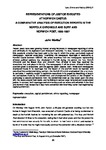Representations of Justice Executed at Norwich Castle: A Comparative Analysis of Execution Reports in The Norfolk Chronicle and Bury and Norwich Post, 1805-1867
| dc.contributor.author | Wallis, John | |
| dc.date.accessioned | 2017-03-20T15:55:38Z | |
| dc.date.accessioned | 2017-04-11T08:44:34Z | |
| dc.date.available | 2017-03-20T15:55:38Z | |
| dc.date.available | 2017-04-11T08:44:34Z | |
| dc.date.issued | 2013 | |
| dc.identifier.citation |
Wallis, J. (2013) 'Representations of Justice Executed at Norwich Castle: A Comparative Analysis of Execution Reports in The Norfolk Chronicle and Bury and Norwich Post, 1805-1867', Law, Crime and History, 3(2), pp.30-51. Available at: https://pearl.plymouth.ac.uk/handle/10026.1/8880 | en_US |
| dc.identifier.issn | 2045-9238 | |
| dc.identifier.uri | http://hdl.handle.net/10026.1/8880 | |
| dc.description.abstract |
Recent years have seen growing interest among historians in newspaper reporting of crime and criminality in the eighteenth and nineteenth centuries. To date, however, comparatively little academic attention has been paid to the way in which the press, particularly regional newspapers, reported executions. Examining the newspaper reportage of executions at Norwich Castle between 1805-67, this article examines how two newspapers representing different political opinions that circulated in Norfolk during the period, the Tory Norfolk Chronicle and the liberal Bury and Norwich Post, differed in how they reported the executions that took place in the city. The newspapers, it will be shown, differed in both the attention given to executions, and the agenda taken towards them. While both newspapers expressed hopes in its reportage that the lesson of the scaffold would be learned, and described the condemned dying penitent, the Norfolk Chronicle emphasised this a lot more. In particular, it explicitly sought to legitimate executions in its pages by describing at length the confessions made by the condemned, and championed the actions of the Chaplain in attempting to secure confessions from the condemned even as they stood upon the drop with the noose around their necks, and by linking in various ways temporal and supernatural justice. In contrast, both reportage and commentary such as letters and editorials in the Bury and Norwich Post, reveal that it was more concerned with reforming, rather than legitimating, capital punishment. | en_US |
| dc.language.iso | en | en_US |
| dc.publisher | University of Plymouth | |
| dc.rights | Attribution 4.0 International (CC BY 4.0) | * |
| dc.rights.uri | https://creativecommons.org/licenses/by/4.0/ | * |
| dc.subject | execution | en_US |
| dc.subject | capital punishment | en_US |
| dc.subject | crime reporting | en_US |
| dc.subject | newspaper representation | en_US |
| dc.title | Representations of Justice Executed at Norwich Castle: A Comparative Analysis of Execution Reports in The Norfolk Chronicle and Bury and Norwich Post, 1805-1867 | en_US |
| dc.type | Article | en_US |
| dc.type | Article | |
| plymouth.issue | 2 | |
| plymouth.volume | 3 | |
| plymouth.journal | SOLON Law, Crime and History |



